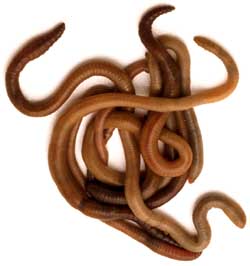DK Nature: Worms
Earthworms are the most familiar worms, but there are thousands of other types of these soft, legless creatures. Some are microscopic, others grow to several yards long. Earthworms and roundworms are tube-shaped. Flatworms are shaped like leaves or ribbons.
Worms live on land and in water and can be found in virtually every habitat on Earth. Earthworms live in the soil. Leeches and bloodworms inhabit ponds and rivers. Most ribbon worms and some flatworms live in the oceans. Ragworms and lugworms are found on the seashore. Some worms are PARASITES that live on or inside other animals.
Some flatworms have simple eyes that can detect light, but most worms are blind. Their most important sense is touch. The earthworm’s skin picks up vibrations caused by sounds or movements. Some predatory worms have sensitive tentacles on their heads, which help them to capture their food.
There are over 100,000 species of worm in three main phyla:
| Flatworms (includes turbellarians, tapeworms, and flukes) |
| Segmented worms, or annelids (includes earthworms, lugworms, ragworms, and leeches) |
| Roundworms (includes threadworms and pinworms) |
Parasites live on or inside other animals or plants, called their hosts. They feed on the blood or tissues of their host, or steal its food. Some parasitic worms in people survive without their host even noticing. Others can cause serious diseases.
Leeches use suckers on their head and tail to latch on to animals, including humans, in order to suck their blood. They inject a chemical that keeps the host’s blood flowing freely. This lets them feed until they are bloated; then they drop off. Leeches lurk in ponds, streams, and other wet places.
Tapeworms live in the guts of animals such as pigs, cats, and humans. The host becomes infected when it eats food containing tapeworm eggs or young. Inside the gut, the worm feeds on the host’s half-digested food. As it matures, the worm produces small packages of eggs, which pass out of the victim’s body.

